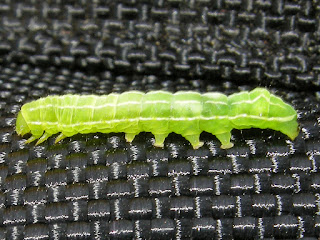Hydroptila sparsa, Bintree Mill, 10th May
That evening my first migrant moth of the year turned up in the trap, a Diamond-back Moth Plutella xylostella.
Diamond-back Moth Plutella xylostella, North Elmham, 10th May
Also in there was this Narrow-winged Pug, a moth I've often seen on heaths but rarely at home (I had one worn specimen here last year).
Narrow-winged Pug, North Elmham, 10th May
Not much else: Common Flat-body Agonopterix heracliana, Bee Moth Aphomia sociella, Red Twin-spot Carpet, Shoulder Stripe (a different one to yesterday's, getting late for these), Streamer, Brindled Beauty, Muslin Moth, Cinnabar, Least Black Arches and Hebrew Character.
Caddisflies included Glyphotaelius pellucidus, 2 Limnephilus auriculas and Limnephilus sparsus.
Next day I headed up to Burnham Overy again for birding, but as always kept my eye out for moths and other things too. The most obvious moths were Cinnabars, at least 5 of which were seen, but some smaller things too. I found Feathered Bright Incurvaria masculella, Green Long-horn Adela reaumurella and 2 Plain Fanners Glyphipterix fuscoviridella. I always think the latter look rather special when fresh, a shiny silvery-grey colour with a bright white terminal band offset from the silvery-grey by a dark band. But in my photos they always look really dull - I can't seem to capture their subtle beauty at all.
Plain Fanner Glyphipterix fuscoviridella, Burnham Overy, 11th May
Green Longhorn Adela reaumurella, Burnham Overy, 11th May
I also found this caterpillar on my camera-bag. I'm not very good at caterpillar ID and don't have good references, but I eventually discovered that Sprawler caterpillar looks like this. It's closest relatives don't, so presumably Sprawler it is. Let me know if I'm wrong though, as always.
Sprawler, Burnham Overy, 11th May
Plenty of Small Coppers on the wing at the moment, and a Wall Brown. Also saw a Common Lizard.
That night Brown-spot Flat-body Agonopterix alstromeriana and 2 Dark-barred Twin-spot Carpets were new for the year at home.
Brown-letter Flat-body Agonopterix alstromeriana, North Elmham, 11th May
Dark-barred Twin-spot Carpet (male, gen det), North Elmham, 11th May
Other moths in the trap consisted of Little Dwarf Elachista canapennella, Common Plume Emmelina monodactyla, 2 Streamers, 3 Common Pugs, Yellow-barred Brindle, Brindled Beauty, Lesser Swallow Prominent, Swallow Prominent, 2 Muslin Moths, 2 Cinnabars, 3 Hebrew Characters, Early Grey and Herald.
Herald, North Elmham, 11th May
Other stuff included caddisflies Glyphotaelius pellucidus, 3 Limnephilus auriculas and Limnephilus sparsus, and a Black Sexton Beetle. My first Mayfly of the year had to wait until the FSC guide arrived as I forgot to order that one with the others. Sadly even with that guide I can't be 100% sure which species it is, though it clearly keys to one of the Baetis species. Pretty sure I can rule out what seems to be one of the commonest species, Large Dark Olive Baetis rhodani - a number of features don't seem quite right especially the un-anulated tails. I'm left with a choice between Scarce Olive Baetis buceratus and Medium Olive Baetis vernus. These two species are essentially identical apart from slight differences in their genitalia... but unfortunately the guide does not extend to telling me what those differences are, so I can't check. On the grounds of probability (given their repective statuses) it's likely Medium Olive Baetis vernus.
Olive Baetis sp., likely Medium Olive Baetis vernus but possibly Scarce Olive Baetis buceratus, North Elmham, 11th May











No comments:
Post a Comment